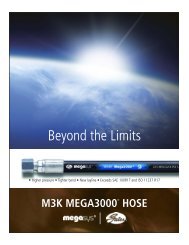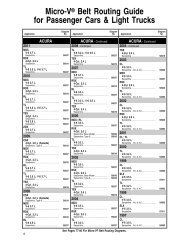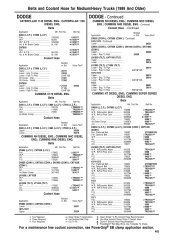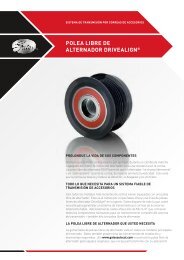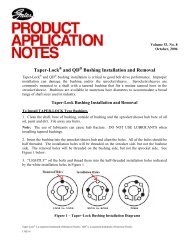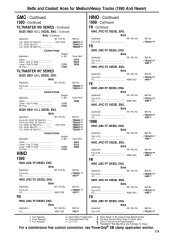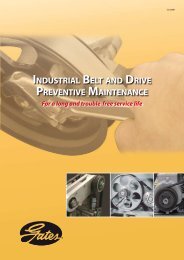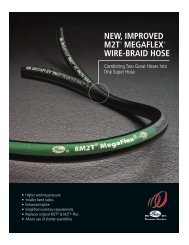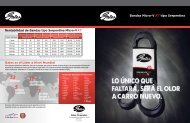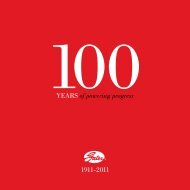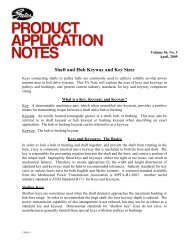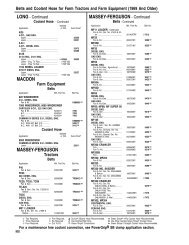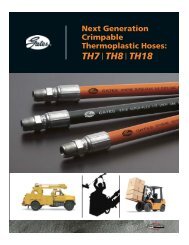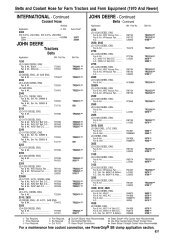PowerGrip® GT® Belt Drives
PowerGrip® GT® Belt Drives
PowerGrip® GT® Belt Drives
Create successful ePaper yourself
Turn your PDF publications into a flip-book with our unique Google optimized e-Paper software.
Synchronous <strong>Belt</strong> <strong>Drives</strong> – Engineering<br />
V. Idler Usage — continued<br />
C. Idler Placement<br />
In synchronous belt drives, idlers can be placed<br />
nearly anywhere they are needed. Synchronous<br />
drives are much less sensitive to idler placement<br />
and belt wrap angles than V-belt drives. The<br />
designer should be sure that at least 6 belt teeth are<br />
in mesh on load carrying sprockets. For every tooth<br />
in mesh less than this (with a minimum of 2), 20%<br />
of the belt torque rating must be subtracted. In<br />
order to minimize the potential for belt ratcheting,<br />
each loaded sprocket in the system should also<br />
have a wrap angle of at least 60°. If a loaded<br />
sprocket has less than 6 teeth in mesh and 60° of<br />
wrap, idlers can often be used to improve this<br />
condition. Non-loaded idler sprockets do not have<br />
tooth meshing or wrap angle restrictions.<br />
D. Spring Loaded Idlers<br />
Using a spring to apply a predetermined force<br />
against a tensioning idler to obtain proper belt<br />
installation tension is acceptable as long as the idler<br />
can be locked down after belt installation.<br />
Dynamic spring loaded idlers are generally not<br />
recommended for synchronous belt drives. If used,<br />
spring-loaded idlers should never be used on the<br />
tight (or load carrying) side. Tight side tensions<br />
very with the magnitude and type of load carried by<br />
the system. High tight side tensions can overcome<br />
the idler spring force allowing the belt to ratchet. In<br />
order to prevent this from occurring, an excessively<br />
high spring force is required. This high spring<br />
force can result in high shaft/bearing loads and<br />
accelerated belt wear.<br />
If dynamic spring loaded idlers are to be used, they<br />
should be used on the slack (or non-load carrying)<br />
side of the drive. Potential drive loading variations<br />
in the system will have the least possible impact on<br />
idler movement due to spring compression with the<br />
idler placed in this way. Be sure to note that the<br />
tight and slack spans shift as the direction of drive<br />
rotation reverses. This could place the spring<br />
loaded idler on the tight side. In some cases, drive<br />
vibration and harmonic problems may also be<br />
encountered with the use of spring loaded idlers.<br />
E. Size Recommendations<br />
Inside idler sprockets can be used in the minimum<br />
recommended size for each particular belt pitch.<br />
Inside flat idlers can be used on the tooth side of<br />
synchronous belts as long as they are of a diameter<br />
equivalent to the pitch diameter of a 40-groove<br />
sprocket in the same pitch. <strong>Drives</strong> with inside flat<br />
idlers should be tested, as noise and belt wear may<br />
occur.<br />
Flat backside idlers should be used with diameters<br />
at least 30% larger than the minimum<br />
recommended inside sprocket size.<br />
Table 13 summarizes our idler size<br />
recommendations.<br />
Table 13 – Idler Size Recommendations<br />
Minimum Minimum Minimum<br />
Inside Backside Inside<br />
<strong>Belt</strong> Idler Idler Flat Idler<br />
MXL 12 grooves 0.50" O.D. 1.00" O.D.<br />
XL 12 grooves 1.00" O.D. 2.50" O.D.<br />
3M HTD ® 12 grooves 0.75" O.D. 1.50" O.D.<br />
5M HTD 14 grooves 1.25" O.D. 2.50" O.D.<br />
2MR GT ® 12 grooves 0.50" O.D. 1.00" O.D.<br />
3MR GT 12 grooves 0.75" O.D. 1.50" O.D.<br />
5MR GT 14 grooves 1.25" O.D. 2.50" O.D.<br />
Contact Gates Application Engineering for additional<br />
information.<br />
F. Specifying Shaft Locations in Multipoint<br />
Drive Layouts<br />
When collecting geometrical layout data for multiple<br />
sprocket drive layouts, it is important to use a<br />
standard approach that is readily understood and<br />
usable for drive design calculations. This is of<br />
particular importance when the data will be provided<br />
to Gates Application Engineering for analysis.<br />
2-Point Drive<br />
When working with a simple 2-point drive<br />
(driveR/driveN only) it is sufficient to specify the<br />
desired distance between shaft centers for belt<br />
length calculations.<br />
3-Point Drive<br />
When working with a 3-point drive<br />
(driveR/driveN/idler), X-Y coordinates are desirable.<br />
It is sufficient, however, to specify desired center<br />
distances between each of the three shaft centers to<br />
form a triangle. In either case, sprocket/idler<br />
movement details for belt tensioning and take-up<br />
are also necessary.<br />
Multipoint Drive<br />
When working with a drive system having more than<br />
3 shafts, the geometrical layout data must be<br />
collected in terms of X-Y coordinates for analysis.<br />
For thos unfamiliar with X-Y coordinates, the X-Y<br />
cartesian coordinate system is commonly used in<br />
mathematical and engineering calculations and<br />
utilizes a horizontal and vertical asis as illustrated in<br />
Figure 7.<br />
-10<br />
-8<br />
Figure 7<br />
-6<br />
-4<br />
10<br />
8<br />
6<br />
4<br />
2<br />
-2 -2<br />
-4<br />
-6<br />
-8<br />
-10<br />
Y<br />
2<br />
Figure 7<br />
4<br />
6<br />
8<br />
10<br />
X<br />
The World’s Most Trusted Name in <strong>Belt</strong>s, Hose & Hydraulics.<br />
53



